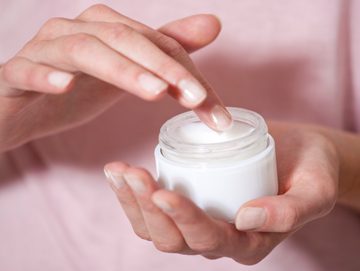
Dry skin remedies
There’s no question that it takes an arsenal of cold-weather cures to get through the slog of Canada’s is-it-ever-going-to-end winters. Head off rough, dry skin with a new seasonal routine of intense pampering that will target skin from head to heel.
According to the experts, one of the best ways to tackle dehydrated skin from the get-go is to put a humidifier in your bedroom during the frigid months. “Once humidity drops below 45 percent, the protective barrier function in our skin becomes compromised and water starts to evaporate from our skin, leading to dryness,” says Dr. Jason Rivers, medical director of Pacific Dermaesthetics and clinical professor of dermatology at the University of British Columbia in Vancouver.
In addition to using a humidifier to help stabilize your skin’s water content, you’ll want to rev up your hydration efforts with heavy-duty formulas. And take a rain check on your usual exfoliation routine, to avoid stripping down already-parched skin and causing irritation, which can lead to redness.
“It’s also important to think about increasing the amount of omega-3 fatty acids in your diet – found in fish and supplements – which have been shown to help dry skin, eczema rashes and dry eyes,” says Dr. Jessica Wu, a dermatologist based in Los Angeles and author of Feed Your Face.
As for products, here’s what our experts suggest will help soothe and smooth.
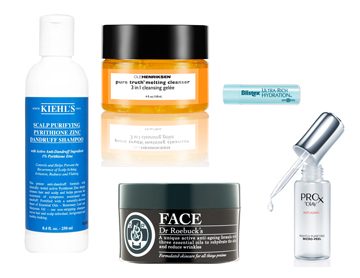
Face and Hair
Come winter, consider switching to a milder cleanser, such as an oil-based formula that doesn’t contain soap, especially if your skin starts to feel a little tight post-washing. You’ll also want to retire any toners (especially those that contain alcohol) for the season, which can be extra-drying, says Dr. Rivers. Moisturizer is a must. The best way to amp up its effectiveness is to apply it while your skin is still damp, as this will help the formula to absorb into the skin and be more effective (this goes for the rest of your body as well). “If you generally use a lotion to moisturize, switch to a formula with the word ‘cream’ in the name, which will have a thicker formulation and contain less water,” says Dr. Rivers.
To help control ultra-dry patches, streamline your exfoliation routine by using a mild chemical formula that contains alpha-hydroxy acids (AHAs), such as glycolic or lactic acid, with no more than five percent concentration, twice a week at most. Always follow with an SPF during the day, and don’t forget to extend the protection to your pucker. “Lips can get chapped and crack and still be susceptible to UV rays on a cold, crisp day,” says Dr. Wu.
When it comes to your hair, don’t assume that an itchy, flaky scalp automatically means dehydration. It could be dandruff, says Dr. Wu. “Dandruff is often due to an overgrowth of yeast that lives on all of us and feeds on our scalp oils.” If you notice flakes, it’s important to wash your hair daily with a shampoo containing zinc, which will help alleviate the inflammation that leads to dandruff.
However, if your scalp is feeling dry without exhibiting any other symptoms (and your hair is similarly parched) try using a deep-conditioning treatment once a week and focus on your roots during application.
Products to try: Kiehl’s Scalp Purifying Anti-Dandruff Shampoo, $26; Ole Henriksen Pure Truth Melting Cleanser, $42; Blistex Ultra-Rich Hydration Dual Layer Balm SPF 15, $4; Olay Pro X Nightly Purifying Micro-Peel, $40; Dr. Roebuck’s Face, $60
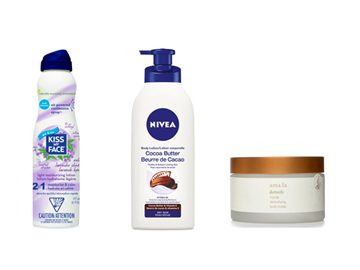
Core
The skin on your back (including your bum) often gets neglected because it’s hard to reach – or simply out of sight. However, forgetting to hydrate these areas can eventually lead to itchy patches and, in extreme cases, even a rash. Switch your everyday body lotion to a heavier cream or butter-type formula and, at the very least, consider a spray-on moisturizer that won’t give you the excuse not to reach back there at all. “Look for ingredients such as shea butter and glycerine, which hold moisture in your skin,” says Dr. Wu. “Argan and coconut oils are excellent for those with sensitive skin or eczema rashes, who may not be able to tolerate synthetic preservatives and fragrances.” Once out of the shower or bath, simply pat your skin dry (avoid rubbing) and massage your moisturizer all over. If you’re planning on wearing tights or skinny jeans, try to let the lotion absorb for five to 10 minutes before getting dressed. Repeat at night, just before bed.
Products to try: Kiss My Face Air Kiss Light Moisturizing Lotion in Lavender Shea, $10; Nivea Cocoa Butter Body Lotion, $10; Amala Detoxifying Body Butter, $36
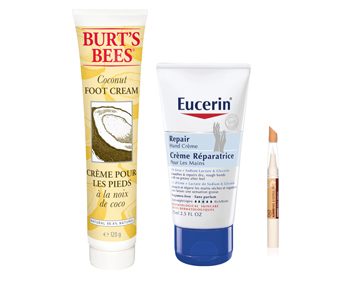
Hands and Feet
Keeping a mega-hydrating hand cream and cuticle oil in your desk drawer (and in your car
and in your purse) is key to maintaining soft hands and healthy nails. Again, look for soothing, moisture-retaining ingredients, such as shea butter and urea to keep your skin supple and soft. “Urea is an ingredient that binds water to your skin and softens thick, dead skin patches, as well as dry cuticles and hangnails. Use it nightly on hands and feet and right after washing your hands,” says Dr. Wu. If your skin is feeling irritated and showing signs of disrepair (such as cracked heels or cuticles), treat your hard-working appendages to a special treatment: Place a few drops of almond oil in a large bowl or pot of warm water and soak for five minutes. Pat dry, then massage your skin with more almond or coconut oil, paying special attention to your nails and cuticles. Wrap up hands or feet in a warm towel (toss it in the dryer for a few minutes first) and relax for 10 to 15 minutes. Alternatively, you can wear a pair of thin cotton gloves or socks and head straight to bed.
Products to try: Burt’s Bees Coconut Foot Cream, $15; Eucerin Repair Hand Creme, $9; The Body Shop Almond Nail & Cuticle Oil, $12
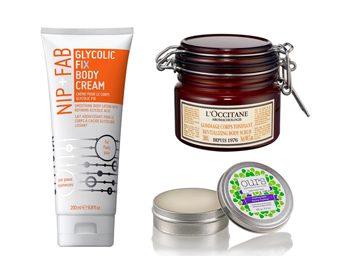
Arms and Legs
If you start to notice flaky skin on your shins or little bumps on your upper arms and thighs, treat yourself to a sugar-based scrub while in the shower or bath. “Chicken skin, or keratosis pilaris, is more prominent in winter because dead skin builds up in the hair follicles,” says Dr. Wu. If you get persistent patches of rough bumps that won’t hit the road, tackle problem areas by using an exfoliating body lotion a couple of times a week. Again, look for a formula with AHAs or urea, which can also help to retain moisture in your skin, says Dr. Rivers. For rough areas that need extra attention, such as knees and elbows, treat them with a heavy balm with soothing ingredients, such as coconut oil and vitamin E, which will help to relieve itch and irritation and create a protective barrier.
Products to try: Nip + Fab Glycolic Fix Body Cream, $13; L’Occitane Revitalizing Body Scrub, $38; Ours Anything Balm, $12
